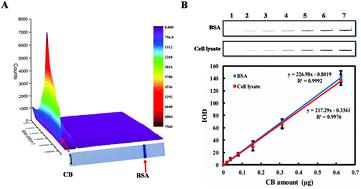Our official English website, www.x-mol.net, welcomes your feedback! (Note: you will need to create a separate account there.)
An SDS-PAGE based method for the quantification of carbon black in biological samples.
Analyst ( IF 4.2 ) Pub Date : 2020-04-01 , DOI: 10.1039/d0an00046a Keyang Liu 1 , Bin Wan
Analyst ( IF 4.2 ) Pub Date : 2020-04-01 , DOI: 10.1039/d0an00046a Keyang Liu 1 , Bin Wan
Affiliation

|
Carbon black (CB) has a wide range of industrial applications and recently has been used as the basic model for environmental health studies on airborne particulate matters (PM). Exposure characterization of CB is always the first and most important step towards a better understanding of its effects on human health. However, efforts were largely limited by the lack of valid methods capable of quantifying CB in biological samples. Here, we developed a new method based on sodium dodecyl sulfate-polyacrylamide gel electrophoresis (SDS-PAGE) for CB quantification in bio-samples, with a detection limit of 4.3 ng. The method is so economical and convenient that it can be performed in most biology labs. The application of the method was successfully demonstrated in three different cell models (mouse macrophage cells (Raw264.7), human epithelial cells (A549) and mouse mesenchymal stem cells (MSC)) and the results showed that the uptake rates decrease in the order of MSC > Raw264.7 > A549. The surprisingly highest uptake rate of MSC deserves further investigation. The novel method provides a complementary quantitative tool to the use of conventional methods such as radioactive and fluorescent labeling and may facilitate related toxicological studies.
中文翻译:

基于SDS-PAGE的生物样品中炭黑定量方法。
炭黑(CB)具有广泛的工业应用,最近已用作空气中颗粒物(PM)的环境健康研究的基本模型。炭黑的暴露特性始终是更好地了解其对人体健康影响的第一步也是最重要的一步。但是,由于缺乏能够定量生物样品中CB的有效方法,工作受到了很大的限制。在这里,我们开发了一种基于十二烷基硫酸钠-聚丙烯酰胺凝胶电泳(SDS-PAGE)的生物样品中CB定量的新方法,检测限为4.3 ng。该方法非常经济且方便,因此可以在大多数生物学实验室中进行。该方法的应用已在三种不同的细胞模型(小鼠巨噬细胞(Raw264.7),人上皮细胞(A549)和小鼠间充质干细胞(MSC)),结果显示摄取率以MSC> Raw264.7> A549的顺序降低。令人惊讶的最高MSC摄取率值得进一步研究。该新方法为使用常规方法(例如放射性和荧光标记)提供了补充的定量工具,并且可能有助于进行相关的毒理学研究。
更新日期:2020-03-05
中文翻译:

基于SDS-PAGE的生物样品中炭黑定量方法。
炭黑(CB)具有广泛的工业应用,最近已用作空气中颗粒物(PM)的环境健康研究的基本模型。炭黑的暴露特性始终是更好地了解其对人体健康影响的第一步也是最重要的一步。但是,由于缺乏能够定量生物样品中CB的有效方法,工作受到了很大的限制。在这里,我们开发了一种基于十二烷基硫酸钠-聚丙烯酰胺凝胶电泳(SDS-PAGE)的生物样品中CB定量的新方法,检测限为4.3 ng。该方法非常经济且方便,因此可以在大多数生物学实验室中进行。该方法的应用已在三种不同的细胞模型(小鼠巨噬细胞(Raw264.7),人上皮细胞(A549)和小鼠间充质干细胞(MSC)),结果显示摄取率以MSC> Raw264.7> A549的顺序降低。令人惊讶的最高MSC摄取率值得进一步研究。该新方法为使用常规方法(例如放射性和荧光标记)提供了补充的定量工具,并且可能有助于进行相关的毒理学研究。



























 京公网安备 11010802027423号
京公网安备 11010802027423号